Turning your home into an eco-friendly sanctuary can often feel like a daunting task. Surprisingly, the trend for sustainable living has led to innovative decor that marries style with conscience.
This article unfolds the latest in green design, offering you simple yet chic ways to transform your space responsibly. Let’s create a beautiful home that cares for our planet!
Key Takeaways
- Opt for eco – friendly materials like bamboo, reclaimed wood, or organic textiles when decorating to minimise environmental impact and enhance indoor air quality.
- Repurposing and upcycling give new life to old items, reducing waste while adding unique personality to home decor.
- Incorporate green technology such as energy-efficient appliances, smart thermostats, and solar panels to lower carbon footprint and save on energy costs.
- Embrace the latest trends like warm neutrals and wellness design elements that promote a calm, health-focused living environment intertwined with nature.
- Consider both DIY projects for a personal touch in sustainable home decor or hire professionals for expert advice and efficient use of environmentally friendly materials.
Sustainable Interior Design: What Is It?
Sustainable interior design focuses on using eco-friendly materials, repurposing and upcycling items, and incorporating green technology to create a more environmentally friendly living space.
It aims to reduce the environmental impact of decorating and designing homes.
Using eco-friendly materials
Choosing eco-friendly materials is a cornerstone of sustainable home decorating. It involves selecting products made from renewable resources like bamboo, cork, or reclaimed wood. These natural choices not only bring an earthy warmth to your space but also promote clean air within your home since they typically contain fewer chemicals than conventional options.
Fabrics such as organic cotton, hemp, and linen add texture while keeping your decor aligned with green living trends.
Opting for paints that are low in volatile organic compounds (VOCs) can also reduce indoor pollution. This makes for healthier living environments free from harmful emissions. As you focus on creating a beautiful yet eco-conscious home with these materials, consider the next step: repurposing and upcycling old items to give them new life and purpose in your décor.
Repurposing and upcycling
Repurposing and upcycling old furniture or household items is a fantastic way to reduce waste and give new life to discarded objects. You can transform an old wooden pallet into a trendy coffee table, or repurpose glass jars into stylish storage containers for your kitchen.
Upcycling not only adds a unique touch to your home decor but also helps in decreasing the demand for new products, thus reducing the environmental impact of manufacturing processes.
By creatively reusing materials, you can inject personality into your home while promoting sustainability. Look for inspiration from online DIY tutorials, and embrace the challenge of transforming discarded items into functional and aesthetically pleasing additions to your living space.
Incorporating green technology
Green technology is essential in sustainable home decorating. Embracing energy-efficient appliances and lighting can significantly reduce your carbon footprint and lower utility bills.
Installing smart thermostats, solar panels, and low-flow water fixtures also contribute to a more eco-friendly home. Additionally, integrating green technology such as recycled materials or energy-saving insulation supports environmentally conscious living.
Thinking about the exterior? Explore ways of integrating sustainability into outdoor spaces with landscaping that promotes local biodiversity and reduces water consumption. Incorporating these practical green technologies enables you to create an environmentally friendly living space while reducing environmental impact.
Top 2024 Sustainable Home Decorating Trends
Warm neutrals are making a comeback in home decor, along with the incorporation of nature into design through mud/laundry rooms and sensory gardens. Wellness design is also gaining popularity as people seek to create spaces that promote health and wellbeing.
Warm neutrals
Choosing warm neutrals for your home decor creates a welcoming and calming atmosphere. Incorporating earthy tones like sandy beige, soft taupe, or creamy ivory into your living spaces can evoke a sense of tranquility and balance.
These colours also provide versatility, effortlessly complementing a range of interior design styles from rustic to modern. By opting for natural and neutral hues derived from the environment, you can create a sustainable and timeless aesthetic that promotes eco-friendly living.
Incorporating warm neutrals in your home decor not only adds visual warmth but also aligns with environmentally conscious choices. Embracing these earthy tones allows you to showcase nature’s elegance while promoting sustainability in interior design.
Pairing natural materials such as wood and organic fabrics with warm neutrals further enhances the eco-friendly appeal of your living spaces.
Incorporating nature in design (mud/laundry rooms, sensory gardens)
Mud and laundry rooms can be designed to incorporate natural elements, such as wooden shelving or bamboo hampers, creating a rustic yet sophisticated feel. The use of sustainable materials like reclaimed wood or organic cotton for soft furnishings adds an eco-friendly touch.
Sensory gardens can be integrated into home design by planting aromatic herbs and flowers, which not only enhance the ambiance but also promote air quality. These green spaces serve as peaceful retreats within homes that foster a deeper connection with nature, making them ideal for environmentally conscious individuals seeking sustainable living ideas.
Wellness design
Enhance your living spaces with wellness design elements to promote a healthy and balanced lifestyle. Integrate natural light, air purification systems, and indoor plants for clean air promotion.
Utilise natural fabrics and low-VOC paints to create a serene sanctuary that supports overall well-being. Embrace the biophilic design by incorporating elements of nature into your interior decor to foster a connection with the outdoors within the comfort of your home.
Create tranquil havens in mud or laundry rooms; enhancing these spaces can bring calmness and stress relief through sensory gardens. Consider introducing features like aromatherapy diffusers or calming colour palettes for relaxation and mental well-being.
How to Incorporate Sustainability into Your Home Decor
Choose eco-friendly materials and furniture, opt for energy-efficient technology, and embrace green landscaping techniques to make your home more sustainable. Read on to discover how you can create an environmentally friendly living space that complements your lifestyle.
Using eco-friendly materials and furniture
Opt for sustainable furniture made from recycled or reclaimed materials, such as wood, metal, or plastic. Choose interior decor items made from natural and organic materials like bamboo, cork, or jute to reduce environmental impact.
Incorporate energy-efficient appliances and lighting fixtures to lower your carbon footprint at home. Consider using non-toxic paints and finishes to create a healthier indoor environment with minimal harmful emissions.
Embrace the use of biodegradable and renewable resources in upholstery fabric and textiles to promote eco-friendly aesthetics throughout your living space.
Create a cohesive design scheme by blending vintage pieces with modern eco-conscious furniture choices. Opt for furnishings crafted from upcycled or repurposed materials to support ethical manufacturing practices while adding character to your interiors.
Choosing energy-efficient technology
When choosing energy-efficient technology for your home, consider investing in appliances with high ENERGY STAR ratings. Look for LED or CFL light bulbs to reduce energy consumption and lower utility bills.
Opt for programmable thermostats to regulate heating and cooling efficiently.
Ensure that the electronics you buy have power-saving features or are ENERGY STAR certified. Selecting energy-efficient technology not only reduces your carbon footprint but also saves you money on utility bills.
By choosing the right technology, you contribute to a greener environment while enjoying long-term cost savings.
Embracing green landscaping techniques
Incorporate sustainable landscaping practices by using native plants to reduce water consumption and support local wildlife. Consider creating a rain garden with drought-resistant plants to manage stormwater runoff effectively.
Employ organic mulch and compost to enrich the soil, foster healthy plant growth, and minimise the need for chemical fertilisers.
Utilise permeable paving materials in your driveways and walkways to decrease water runoff and improve groundwater recharge. Install a rain barrel or cistern system to collect rainwater for irrigation purposes, reducing reliance on potable water sources.
Exterior Decorating Ideas for a Sustainable Home
Bring an earthy touch to your outdoor space by upcycling outdoor pieces and incorporating sustainable landscaping techniques. Creating a sustainable home extends beyond the interior, and there are plenty of ways to make your exterior design eco-friendly as well.
Upcycling outdoor pieces
Transform your outdoor space by upcycling old furniture and decor. Repurpose unused items to create unique pieces that add character to your garden or patio. Use reclaimed wood for DIY outdoor tables, or give old planters a facelift with a fresh coat of paint.
Embrace creativity by turning discarded items into functional and stylish additions to your sustainable landscape design. Incorporating upcycled elements not only adds personality but also reduces waste, contributing to a greener and more environmentally friendly outdoor space.
Revamp tired outdoor furniture using eco-friendly paints and finishes, bringing new life to weathered chairs and tables. Explore thrift stores or online marketplaces for hidden gems waiting for an upcycling project, giving preloved items a second chance while lowering the environmental impact of your outdoor decor choices.
Adding an earthy touch to your landscaping
Amplify the natural appeal of your outdoor space with an earthy touch to your landscaping. Integrate sustainable elements such as native plants, local stones, and repurposed materials to create a harmonious and eco-friendly environment.
Utilise low-maintenance landscaping techniques to reduce water consumption and maintain a green aesthetic all year round.
Craft a tranquil oasis by incorporating organic shapes and textures into your outdoor design. Embrace the beauty of imperfection in natural elements like driftwood, moss-covered rocks, and weathered wood for a rustic yet elegant atmosphere.
DIY Projects vs. Hiring Professionals for Sustainable Home Decor
When it comes to sustainable home decor, DIY projects can be a cost-effective and creative way to incorporate eco-friendly elements into your design. However, hiring professionals may offer expertise and ensure the use of environmentally friendly materials.
The benefits and drawbacks of both options
Deciding between DIY projects and professional help for sustainable home decor brings its own set of advantages and disadvantages. Below you will find an HTML table that lays out key points to consider:
| DIY Projects | Hiring Professionals |
|---|---|
| Encourages personal creativity and customisation. | Professional expertise ensures high-quality results. |
| Can be more cost-effective, reducing project expenses. | Time-saving, as skilled individuals manage the project. |
| Possibility for errors, potentially leading to additional costs. | More expensive due to labour and consultation fees. |
| Gives a sense of accomplishment and connection to the space. | Access to a wider range of materials and sustainable technologies. |
| May take longer to complete without professional tools and techniques. | Professionals can navigate regulations and permits efficiently. |
| Limited access to wholesale or specialised sustainable materials. | Projects are generally completed more quickly and efficiently. |
Opt for DIY projects to weave personal flair into your space or choose professionals to guarantee quality and efficiency.
Utilising Synchrony HOME for support and financing
Maximise your sustainable home decorating project’s potential by leveraging the support and financing options available through Synchrony HOME. Explore eco-friendly furnishing choices, energy-efficient appliances, and other green home features while benefiting from flexible payment plans tailored to suit your budget and needs.
Elevate your environmentally conscious design with ease, knowing that you can rely on Synchrony HOME for assistance in making your sustainable home vision a reality.
Make informed decisions about funding your sustainable home endeavours with the help of Synchrony HOME’s reliable support and diverse financing solutions. Avoid unnecessary stress by accessing financial aid to bring your eco-conscious designs to life, whether it’s purchasing ethically-sourced furniture or incorporating energy-saving technology into your living space.
Conclusion
Incorporating sustainable home decorating trends adds eco-friendly charm to your living space. Envision a warm neutral palette and nature-inspired design elements bringing the outdoors in.
Embrace sustainability, from interior decor to exterior landscaping, for a greener, more conscious lifestyle. Explore DIY projects or seek professional assistance to transform your home into an ethically and sustainably designed haven.
FAQs
1. What is sustainable home decorating?
Sustainable home decorating involves using ecofriendly interior design practices and materials to decorate your home in a way that’s kinder to the environment.
2. Can you use recycled materials for trendy home decor?
Absolutely, incorporating recycled materials into your decor is a key part of green interior design and adds unique character to your space.
3. How does sustainable architecture contribute to ecoconscious design?
Sustainable architecture focuses on designing homes with environmentally friendly features that reduce impact on Earth, aligning perfectly with the principles of ecoconscious design.
4. Are there low-cost ways to achieve an earthy home decorating style?
Yes, by using natural and organic materials or upcycled items, you can create an earthy theme in your home without spending much money.
5. What are some examples of sustainable living decor trends?
Current trends include using ethically sourced furnishings, integrating plants for a natural look, and choosing furniture made from renewable resources for greener interior design.





